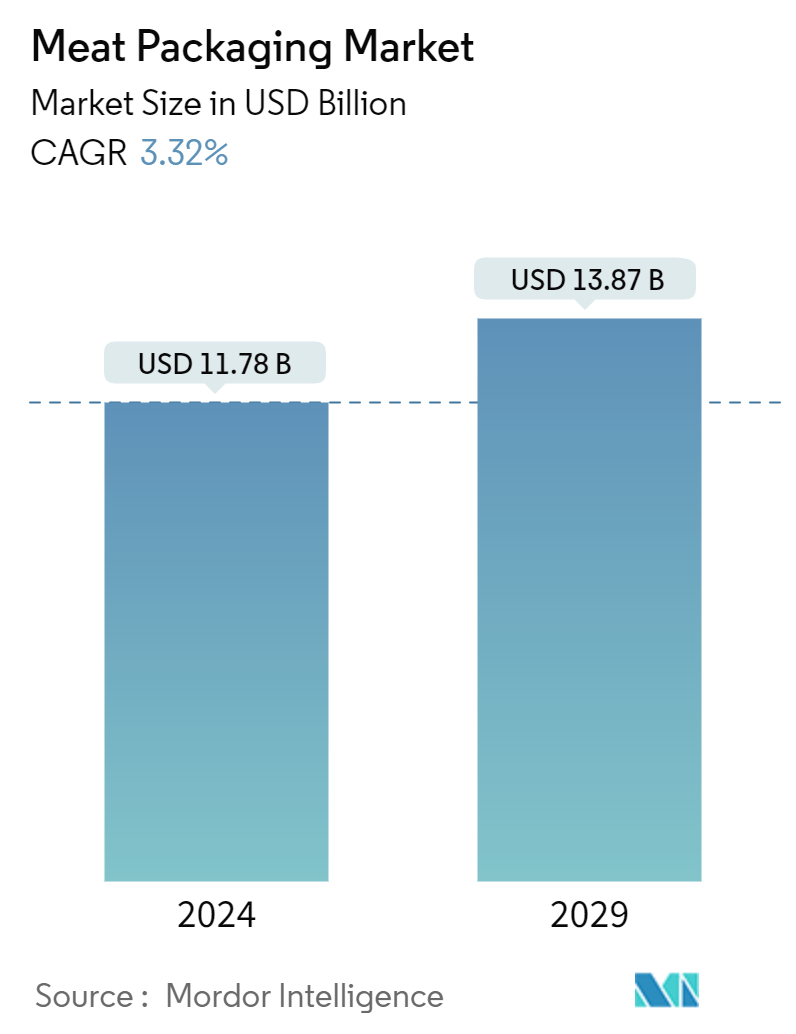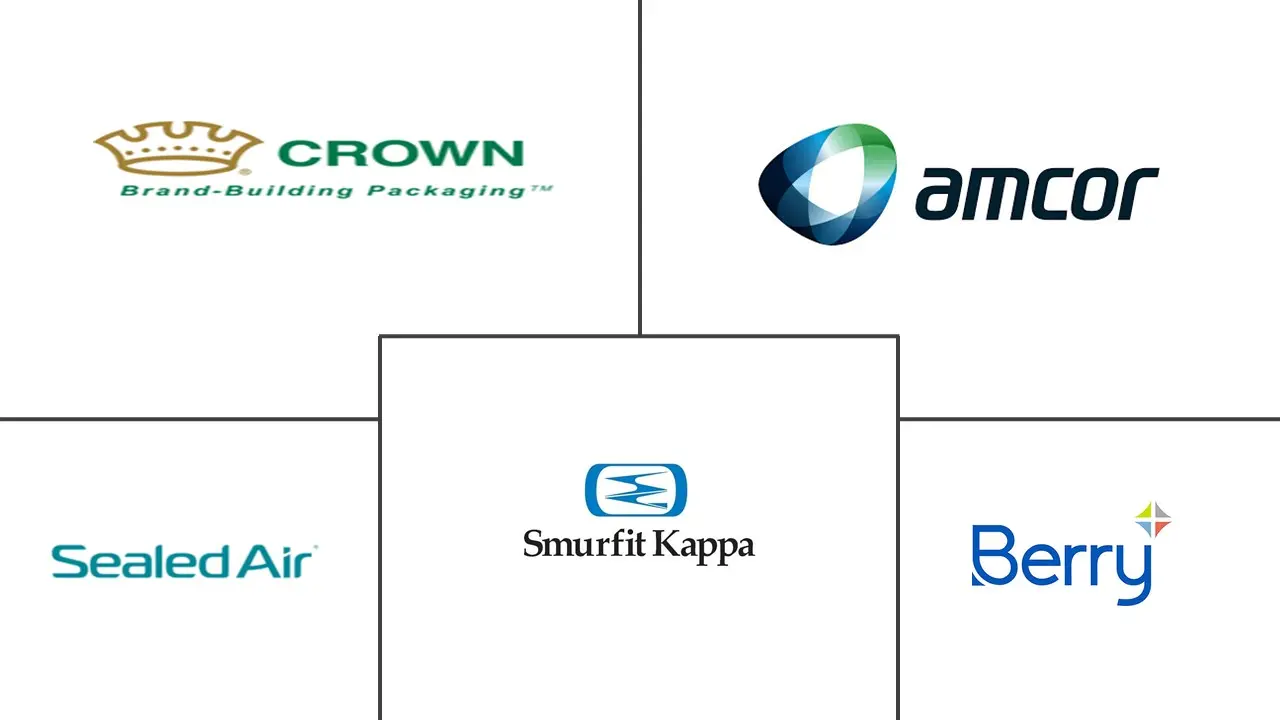Market Size of Meat Packaging Industry

| Study Period | 2019 - 2029 |
| Market Size (2024) | USD 11.78 Billion |
| Market Size (2029) | USD 13.87 Billion |
| CAGR (2024 - 2029) | 3.32 % |
| Fastest Growing Market | Asia Pacific |
| Largest Market | North America |
| Market Concentration | Medium |
Major Players
*Disclaimer: Major Players sorted in no particular order |
Meat Packaging Market Analysis
The Meat Packaging Market size is estimated at USD 11.78 billion in 2024, and is expected to reach USD 13.87 billion by 2029, growing at a CAGR of 3.32% during the forecast period (2024-2029).
With the growing demand for meat products, the need for quality and attractive meat packaging is rising. Packaging can help maintain the quality of meat and delay the onset of spoilage by controlling the factors contributing to it.
- Like many other industry areas, meat packaging innovation has been under high pressure to achieve hygiene and quality control while reducing emissions and material use. These demands are further compounded by rising raw material prices, cost inflation, and supply chain issues that have cascaded over the past three years.
- One of the crucial factors in meat packaging is the type of meat being packaged. Large pork and beef packing plants use vacuum packaging to preserve meat. Vacuum packaging removes oxygen within the package, which helps to maintain the meat within the packaging. Grocery stores mostly use stretchable plastic meat film and a bottom foam tray.
- According to the OECD and FAO, the per capita meat consumption worldwide is projected to increase to 34.9 kilograms by 2024. There is a strong demand for products like packaged meat, mainly because most consumers worldwide prefer the convenience of ready-to-serve foods. For instance, according to the US Department of Agriculture and Economic Research Service, the most consumed type of meat in the United States was broiler chicken, at about 91 pounds per capita. This is expected to increase to 94.3 pounds per capita by 2028.
- During COVID-19, active packaging manufacturers were flooded with challenges like supply chain disruptions, lack of availability of raw materials used in the manufacturing process, labor shortages, fluctuating prices, etc. In addition, international trade disputes, economic inflation, raw material shortages, and the Russo-Ukraine war have steadily raised higher and higher hurdles for packaging producers as they strive to achieve ambitious circular economy targets. The Russo-Ukraine war further resulted in economic sanctions against several countries, a jump in commodity prices, and supply chain disruptions that have impacted many markets worldwide.
Meat Packaging Industry Segmentation
Packaging plays a vital role in preserving the term and extent of the shelf life of meat. The meat can be compromised without packaging as it is contaminated by direct contact with chemical, physical, and biological contaminants. The study tracks the demand for the market through the revenue accrued by the value of the consumption of different types of packaging solutions used for meat packaging.
The market is segmented by material type (plastic and metal), type of meat (fresh and frozen, processed, and ready-to-eat), and geography. The scope of this study is currently focused on the key regions, such as North America, Europe, Asia-Pacific, Latin America, and the Middle East & Africa. The market sizes and forecasts are provided in terms of value (USD) for all the above segments.
| By Material Type | ||||||||
| ||||||||
| ||||||||
|
| By Type of Meat | |
| Fresh and Frozen | |
| Processed | |
| Ready to Eat |
| By Geography | |||||||
| |||||||
| |||||||
| |||||||
|
Meat Packaging Market Size Summary
The meat packaging market is experiencing a steady expansion, driven by the increasing global demand for meat products and the necessity for high-quality, appealing packaging solutions. This growth is fueled by the rising consumption of meat, particularly in regions with burgeoning urban populations like Asia-Pacific, where lifestyle changes are leading to a preference for processed and pre-prepared meat products. The market is characterized by a strong demand for flexible packaging solutions, which are essential for extending the shelf life of meat products and maintaining their quality. Innovations in packaging technology are crucial as companies strive to meet the dual challenges of enhancing hygiene and quality while minimizing environmental impact through reduced material use and emissions.
The industry is facing several challenges, including fluctuating raw material prices, supply chain disruptions, and the need to adapt to economic fluctuations and geopolitical tensions. These factors have prompted market players to focus on strategic collaborations and technological advancements to maintain competitiveness. The market is also witnessing a shift towards sustainable packaging solutions, with companies introducing recyclable and environmentally friendly options. Despite these challenges, the meat packaging market is poised for growth, supported by the increasing popularity of ready-to-eat and ambient foods, as well as the ongoing development of food technology to meet the demands of modern consumers.
Meat Packaging Market Size - Table of Contents
-
1. MARKET DYNAMICS
-
1.1 Market Overview
-
1.2 Industry Value Chain Analysis
-
1.3 Industry Attractiveness - Porter's Five Forces Analysis
-
1.3.1 Threat of New Entrants
-
1.3.2 Bargaining Power of Buyers
-
1.3.3 Bargaining Power of Suppliers
-
1.3.4 Threat of Substitute Products
-
1.3.5 Intensity of Competitive Rivalry
-
-
1.4 Assessment of COVID-19 Impact on the Meat Packaging Industry at a Global Level
-
-
2. MARKET SEGMENTATION
-
2.1 By Material Type
-
2.1.1 Plastic
-
2.1.1.1 Flexible (By Product Type)
-
2.1.1.1.1 Pouches
-
2.1.1.1.2 Bags
-
2.1.1.1.3 Films and Wraps
-
2.1.1.1.4 Other Flexible Products
-
-
-
2.1.2 Rigid (By Product Type)
-
2.1.2.1 Trays and Containers
-
2.1.2.2 Other Rigid Products
-
-
2.1.3 Metal
-
2.1.3.1 Aluminum
-
2.1.3.2 Steel
-
2.1.3.3 Other Material Types
-
-
-
2.2 By Type of Meat
-
2.2.1 Fresh and Frozen
-
2.2.2 Processed
-
2.2.3 Ready to Eat
-
-
2.3 By Geography
-
2.3.1 North America
-
2.3.1.1 United States
-
2.3.1.2 Canada
-
-
2.3.2 Europe
-
2.3.2.1 United Kingdom
-
2.3.2.2 Germany
-
2.3.2.3 Spain
-
2.3.2.4 Russia
-
2.3.2.5 Rest of Europe
-
-
2.3.3 Asia-Pacific
-
2.3.3.1 China
-
2.3.3.2 Japan
-
2.3.3.3 India
-
2.3.3.4 Australia
-
2.3.3.5 Rest of Asia-Pacific
-
-
2.3.4 Rest of the World
-
2.3.4.1 Latin America
-
2.3.4.2 Middle East and Africa
-
-
-
Meat Packaging Market Size FAQs
How big is the Meat Packaging Market?
The Meat Packaging Market size is expected to reach USD 11.78 billion in 2024 and grow at a CAGR of 3.32% to reach USD 13.87 billion by 2029.
What is the current Meat Packaging Market size?
In 2024, the Meat Packaging Market size is expected to reach USD 11.78 billion.

